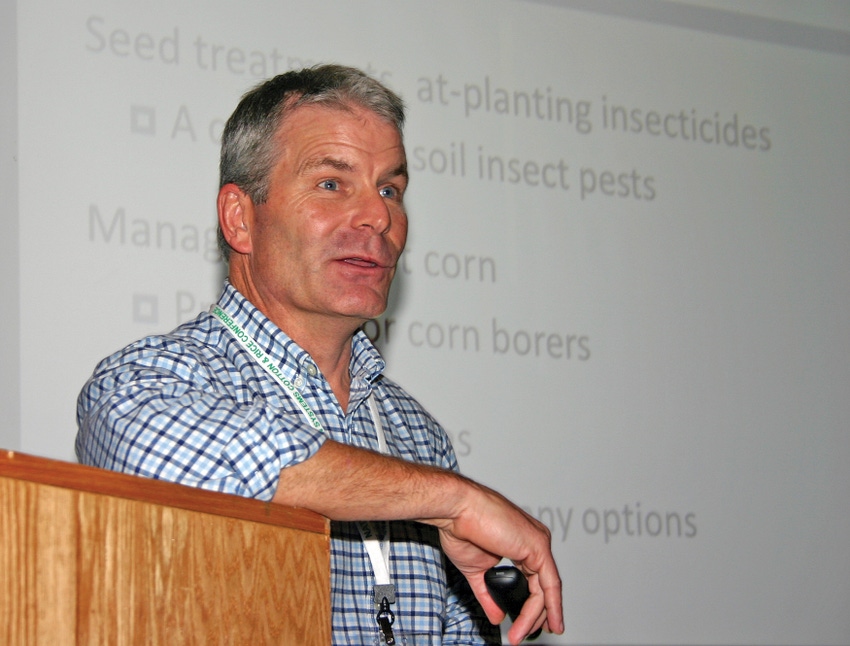
One of the big issues Mid-South corn producers frequently deal with is simply getting a good stand.
“Corn is one of the most sensitive crops we have to stand loss and uneven stands,” said Scott Stewart, University of Tennessee entomologist, at the recent Cotton and Rice Conference in Tunica, Miss. “You need the right plant population, you need an even plant population.
“We’ve come a long way. We now have vacuum planters. We’re doing so much better in our corn production.”
With a good Bt package, Stewart said corn is rather simple to grow once it’s out of the ground with a good stand. It’s not an intensive insect-management crop, which is attractive.
“Poll all the entomologists in the Mid-South and I’d guess every one of them would say you need an at-planting insecticide. Either use a seed treatment, an in-furrow treatment, or both.
“I’ve been in fields in Mississippi where the producer didn’t have a stand left when the bugs got done with it. One of those scenarios was in a field with a clover cover crop. He burned it down a bit late and had a bunch of spotted cucumber beetle larvae. He planted into that anyway.”
Stewart hasn’t seen Southern corn rootworm in 10 years except in a few sweet corn fields. “That’s because we’re using seed treatments. But remember some cover crops can be a ‘bridge’ to the main crop.”
If you’re buying corn seed, said Stewart, “you’re going to get an insecticide seed treatment. It’s standard. The one you get pretty much depends on which company you buy from – Dekalb and Poncho, Pioneer and Cruiser. Standard rates are 250 milligrams.
“Ninety percent of the time those are very good seed treatments. In most of my tests that’s all that’s needed.”
However, that isn’t always the case. There are some risk factors to consider, said Stewart. “Do I choose one over the other? Should I special order a higher seed treatment rate? There is a trend in the industry to move up to a rate of 500 (milligrams) as a base treatment. My experience has been the higher rate is more beneficial as you move farther south.”
Last year, Stewart visited a 500-acre field with sugar cane beetles. The producer had taken a bermudagrass pasture, burned it down and planted.
“That’s like putting out a ‘come eat me’ sign. Anytime you’re taking a field out of CRP, pasture, sod or the like, you must use the highest seed treatment rates or consider supplementing the basic seed treatment rates with something in-furrow.”
No-till practices increase pest risks a bit. “I haven’t had much trouble in my fields as long as there’s a timely burndown and keeping a three or four week interval of almost bare dirt before planting. But that’s pretty tough in west Tennessee.”
What about cutworms?
“If you burndown late, think about this pest. We have a lot of Bt technologies that control cutworms when they’re small. But if you plant into a field full of cutworms, they’ll cut plants and cause injury before they die. I’m not comfortable enough with the Bt technologies to say they can stand alone.”
There is one thing Stewart sees producers waste money on every year in Tennessee. “Three week before planting they burndown and throw a pyrethroid in to kill cutworm. You really need to apply that cutworm application plus or minus a week of planting. That will affect the control the pest in the field.”
Revised thresholds
Mississippi and Tennessee have revised their treatment thresholds in non-Bt corn. “We’ve gotten quite a bit more aggressive based on data. We’re also triggering more applications based on moth-trapping. It used to be ‘treat if 20 percent of your plants are infested.’ Well, our data shows that by the time 20 percent of your plants are infested, you’ve got yield loss.
“So, we’re saying to treat when first generation, whorl stage, 5 percent or more of your plants are infested with either eggs or small larvae.
“Or, if you run pheromone moth traps, treat when you’ve caught 50 or more moths in a week.”
After tassel up until R-3, a new recommendation is to treat when you have 10 percent or more infested plants. “It used to be about 20 percent. Really, we’re saying anytime you catch 100 or more moths per week during the crop’s sensitive stage, consider a treatment in the next four or five days.
“But the reality is the vast majority of our acres manage corn borers with Bt corn.”
What about the “old” Bt versus “new”?
“With the old Bt technologies – YieldGard, Herculex, Bt3 – if you’re in an officially-designated cotton-growing area, there’s supposed to be a 50 percent non-Bt refuge. In a non-cotton-growing area that refuge could drop to as little as 20 percent.”
As for the newer technologies, companies are putting in more traits. As a result “they’re getting redundant control of corn borers – built-in resistance management is the hope. Because of that, for most of the varieties in cotton- and corn-growing areas, the refuge requirement is reduced.”
It’s pretty simple in cotton-growing areas, said Stewart. “You can reduce the non-Bt refuge requirement to 20 percent.”
Meanwhile, in a corn-growing area, there are many options. “With some of them, you can go down to a 5 percent refuge. You can plant a refuge in a bad where the seed is mixed in. Some require a 10 percent refuge, depending on the traits. Some stick to 20 percent. Do your best, make an honest effort.”
About the Author(s)
You May Also Like




